Cantaloupes are the world’s most beloved fruits found everywhere. Many enjoy growing Cantaloupes at home but often face frustrating problems. Cantaloupe’s most significant problems are leaf coloring, dying plants, pests, slow fruiting plants, plants that do not produce fruit and splitting melons. However, you can solve these problems with a better water strategy, pesticides, fungicides, or location adjustments.
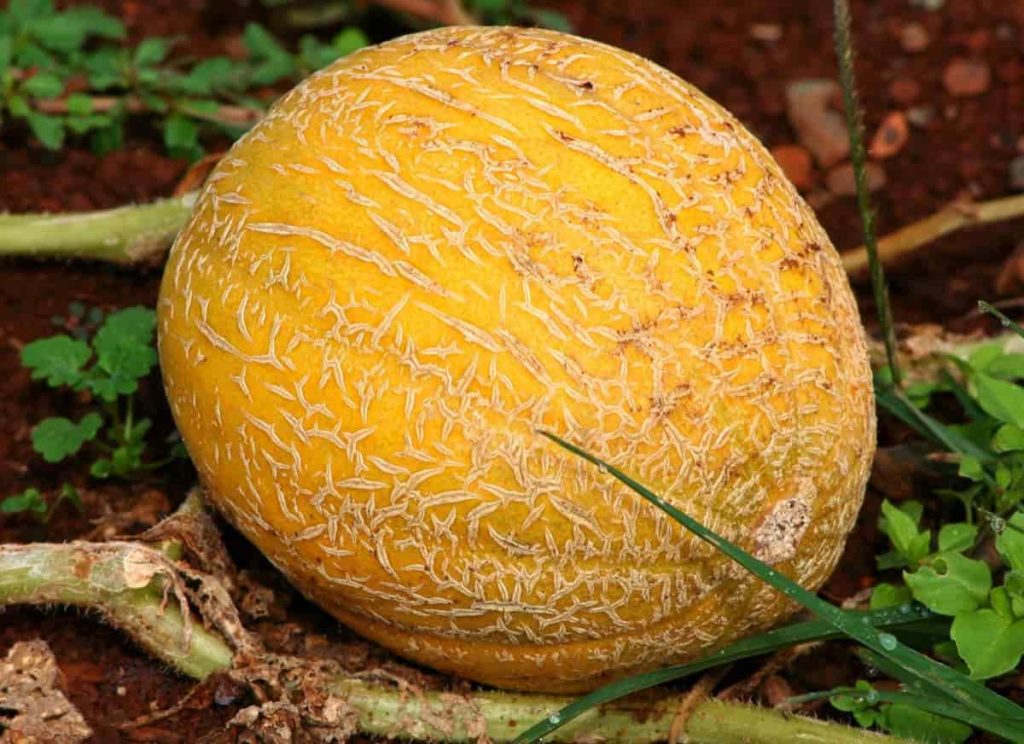
Cantaloupes grown in a home garden offer a crop full of delicious, edible fruits. However, when insects attack, your otherwise healthy hot weather crops get cosmetically damaged and often die. While infections result in varying degrees of damage, the moment you feel any abnormalities on your crops is key to preventing and controlling problems arising.
Always provide the best care as the first line of self-defense against pest problems, as healthy, unstressed Cantaloupes can avoid and control infections more than unhealthy, stressful ones.
Common Cantaloupe/Muskmelon plant problems
Cantaloupe flowers but no fruit
There are three common reasons for Cantaloupe flowering but no fruit the imbalance of male to female flowers, nematodes, and lack of pollination.
Too many male flowers
Sometimes, your plant will have many male flowers, no matter what. Check to see what flowers you have. Usually, male flowers appear first, with female flowers appearing a few days or weeks later. Bad weather, like too much rain, can sometimes cause female flowers to appear later.
If you have many male flowers, you may have to wait a little while until the female shows up. However, even Cantaloupes cannot produce female flowers due to high temperatures. The ideal growing range for Cantaloupe is between 18 to 35°C. If it gets hotter, Cantaloupe vines can only produce male flowers.
Solution – To help prevent this, make sure you plant Cantaloupe early enough and have plenty of time to bloom before they are too hot. And if the temperature is suitable, you may need to wait a little longer for female flowers to appear on plants.
Due to nematodes
The nematode is a pest that can cause many problems for Cantaloupe. The standard type affecting melons is called root-knot nematodes, which cause a root-knot disease. The root-knot can cause Cantaloupes not to make fruit, meaning you will have lots of flowers but no fruits.
Solution – Rotating the Cantaloupe planting helps, so you don’t have potential host plants in the same soil for more than a year. Additionally, you can often go up to the soil and plant a covered crop of cereal rye or wheat for winter. Harvest the crop in spring and put it in the soil before planting your Cantaloupes.
In case you missed it: Best Fertilizer for Cantaloupe/Muskmelon – Homemade, Organic, Liquid, NPK, Compost, How and When to Apply
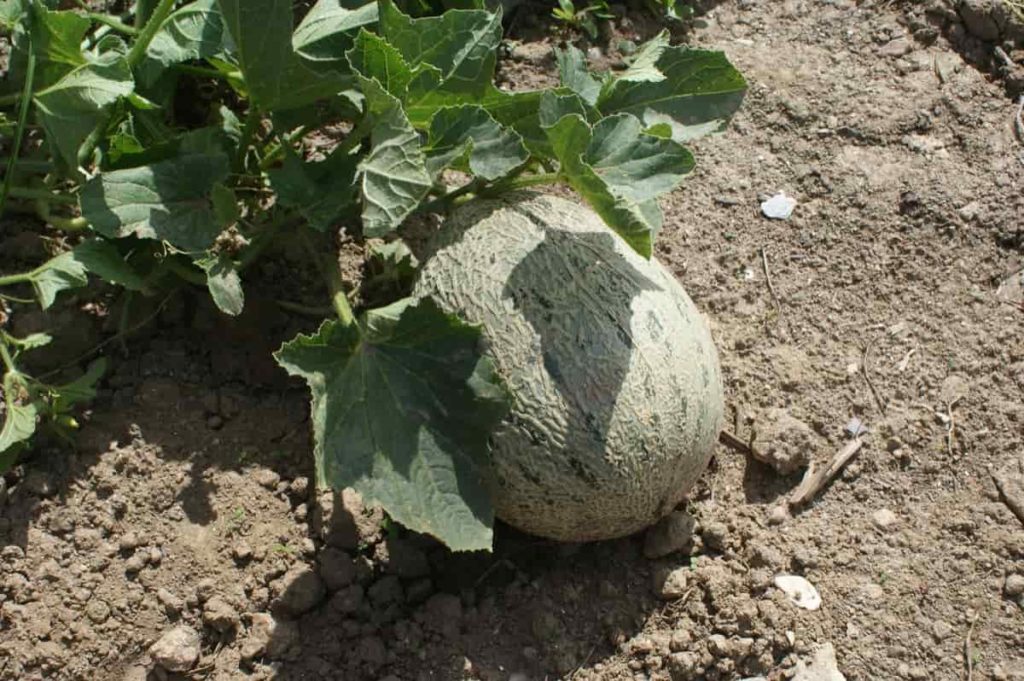
This will help in killing nematodes and prevent them from multiplying. If you have a serious nematode infection, you may need to consider more aggressive control methods such as sanitization and hate treatment. If your nematode attack is serious, think of a natural way of control involving Marigolds.
Due to lack of pollination
The most common reason why Cantaloupes flower is because they are not pollinating. Although perfect flowers do not need outdoor pollination, other matter, flowers on the plant do. Therefore, you can make a beautiful flower patch as the completion of your Cantaloupe garden.
Solution -Some things make it more difficult for flies to stay around. Pesticides or insecticides that harm bees should be avoided, and even if your neighbors are using them on their flowers, they can still affect bees in your garden. Moreover, the flies will not leave and do their job if it rains. So, if you know there are flies in this area, but it has rained a lot, it can affect why they are not pollinating your plants.
If the flies are not just helping enough, you can also pollinate your Cantaloupe by hand. It is pretty simple but needs care. First, identify male and female flowers on your Cantaloupe plants. Next, use your brush to gently sweep inside the stamen, moving to small circles and covering the brush in pollen. Then, brush the female flower’s stigma and gently brush the pollen. A male flower can pollinate multiple female flowers, although limiting the job to more than four is better.
Cantaloupe leaves turning yellow
Cantaloupe leaves turn yellow due to excessive water. Yellowing of leaves is also seen in cases of white fly and spider mite attacks. The mosaic virus infection also causes the yellowing of leaves in Cantaloupe plants.
Overwater
Perhaps the most common reason the leaves are yellow is to give more water. You need to remember that melon plants love wet soil.
In case you missed it: Growing Muskmelon Indoors from Seed – a Full Guide
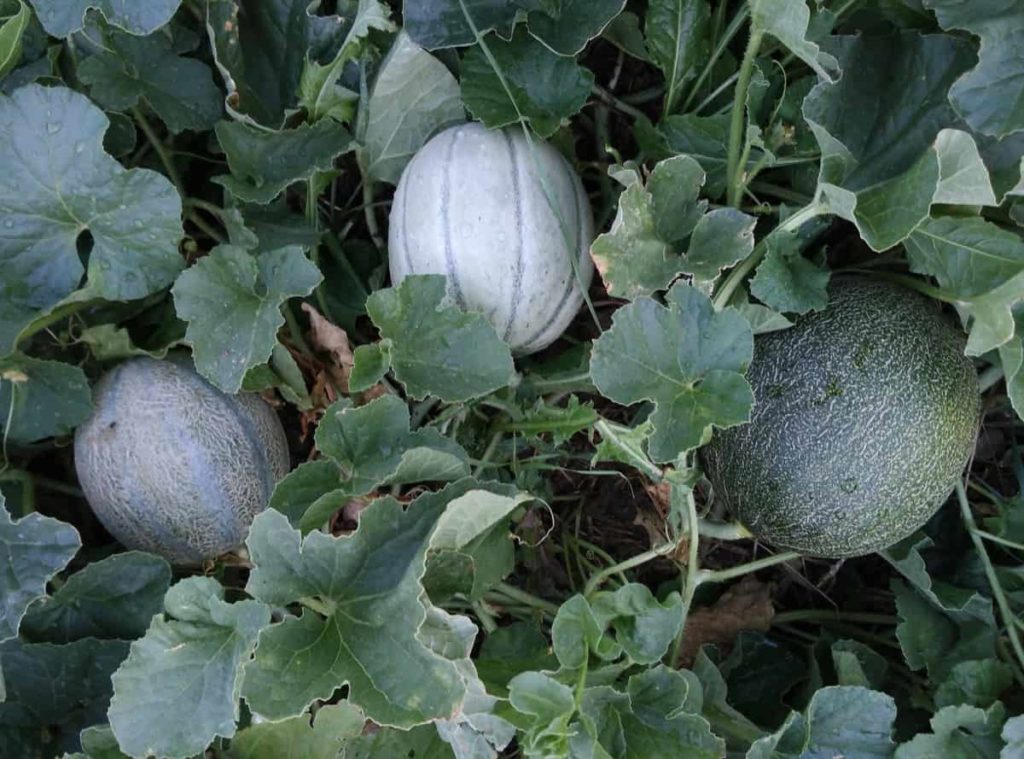
Solution – Check the soil with your fingers and water when needed only when the soil dries up to 2 inches. Use a sprinkler irrigation system if you can give it the right time; it helps the plant to provide only enough water.
Whitefly
The whitefly population increases in spring. You would like to spray something before spring to prevent a massive attack. White fly grows rapidly and thus has led to resistance to many pesticides.
Solution – Hang yellow, sticky cards around plants to quickly identify their presence. If you look at whiteflies, you’d like to remove them with a strong stream of water. You can biologically control whiteflies by introducing ladybugs and lacewing larvae. If this attack is severe, you can use insecticidal soap to eliminate these pesky insects. You can sprinkle neem oil if you want to use organic alternatives.
Spider mites
Spider mites are small insects that are almost invisible to the naked eye. However, one can identify their presence through the webcasts they leave at and around leaves.
Solution – Water your Cantaloupe plant properly as spider mites prefer dry conditions. Once you see them try to wash them with a strong stream of water.
Mosaic virus
This virus causes the leaves to be yellow and distorted and turn yellow. If you can control the aphids, you can probably control the virus because aphids transmit the virus.
Solution – Dispose of infected plants as there is no way to treat them. Clean the tools you use on affected plants. Plant resistant species in the future.
Cantaloupes rotting and cracking on the vine
The culprit behind the Cantaloupes rotting on the vine is called southern blight. The southern blight causes Cantaloupes to rot down and destroy the fruit’s interior, making it damaged and inedible. Cantaloupe plants are particularly susceptible to this problem if grown in areas with minimal shade and excess water.
Solution – You can apply a single layer of mulch between Cantaloupe fruits and the soil to prevent southern blight effects and chemical supplement affliction. You can water your Cantaloupe patch in small quick intervals to avoid a collection of water standing around plants.
Cantaloupe that looked healthy has suddenly cracked and opened up in patches, exposing it to the elements and turning it into an invitation for all kinds of critters. The main reason why Cantaloupes and other melons crack on the vine is suddenly due to excessive water logging.
Solution – Those cracking melons as an issue that you cannot prevent because it is often caused by rain and not by human error. Unfortunately, this is an issue that you cannot stop. However, you can keep up the walk with normal water and compost the bursting Cantaloupes.
In case you missed it: 22 Common Problems of Watermelon Plants: How to Fix Them, Solutions, and Treatments

Blossom end rot
Bloom end rot is caused by calcium deficiency. Usually, the first obvious sign of blossom end rot is a depressed rot at the end of the fruit. Once the fruit shows signs of rot, it is advisable to get rid of it.
Solution – You can also cut the end of the fruit to try to save the rest, believe there is no secondary opportunistic fungus or mold. You should start applying sprays to help protect future fruits from saving the developing fruits.
Cantaloupes are slowly growing or not ripening
You should be somewhat concerned if your Cantaloupes are slowly growing or not ripening. When your Cantaloupes don’t get enough sunshine, they won’t grow at normal rates and lag in their maturity. You may have also applied your Cantaloupes closer to each other, which means they will be fighting for nutrients in the soil and will not grow normally.
Solution – To combat these two problems, you will need to make sure you plant your Cantaloupes in a full sun area of your garden (perhaps choose to replant them gently) as well as make sure they are well planted by each other.
Tasteless Cantaloupes
Excess water can cause the taste to be too bland.
Solution – Like most crops, Cantaloupes grow and taste at best when they get a steady supply of moisture, not too much, not too little. Of course, rain doesn’t always cooperate, and we had some street washers this season with extreme heat between them.
Another possibility is soil nutrition.
Solution – Cantaloupes are heavy feeders and appreciate a good topping of horse or cow manure while adding compost and a few booster fertilizations during each fall and growing season. Plants are balanced or slightly more like nitrogen fertilizer early in the season, then phosphorus and potassium apply after the plant’s flower. Try checking your soil to see if you have any important flaws.
Another sweetener killer is anything that damages or lessens the plant’s leaves.
Solution – Leaves are responsible for taking sunlight energy, which helps produce these sugars in the fruit. Diseases, bugs, or even the size of only small leaves are all possible drawbacks due to dehydration, poor nutrition, or inferior soil.
The variety is another factor. You can reject it if you have applied the same type this year. But if you’ve added a different variety this year, it might not be just as suitable for our soil and temperature. The solution would be to go back to what you grew first.
In case you missed it: Best Fertilizer for Watermelon: Homemade, Organic, Compost, Natural, Liquid, When and How to Apply
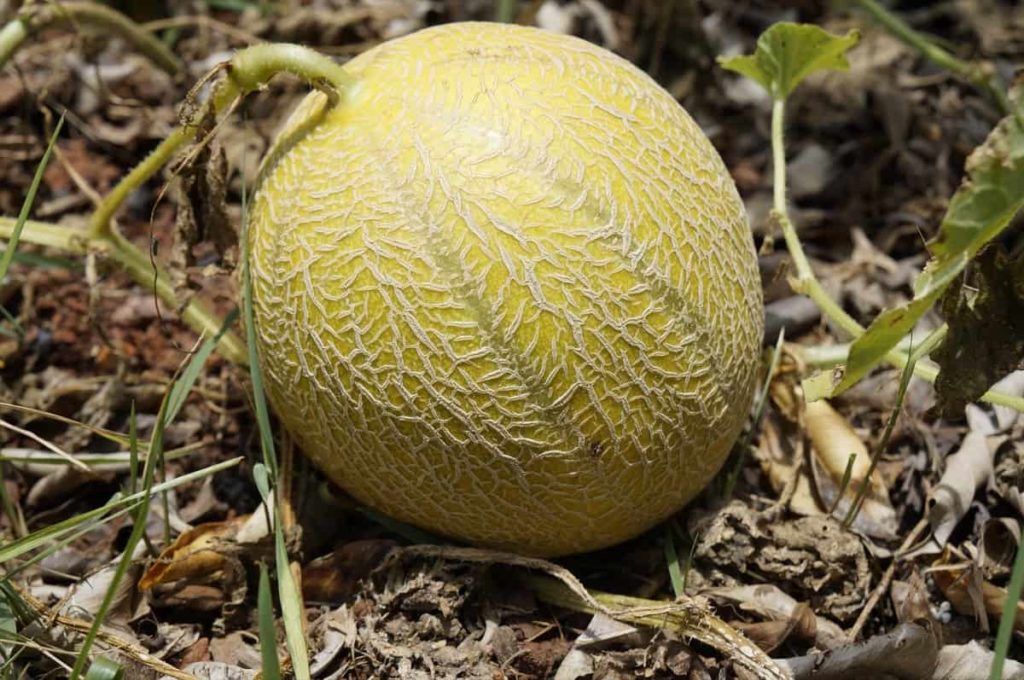
Solution – If many fruits are ripened simultaneously, they must distribute the available sugars. It means you’ll get more fruit, but they’ll all be less sweet. So farmers often pinch the developing fruits so that only one of them can ripe every two weeks.
Diseases
Alternaria leaf blight
Small, yellow-brown spots with yellow or green halos first appear on the oldest leaves. Then, lesions coalesce, leaves turn, and eventually die.
Solution – The Cucurbits should be rotated with another crop every two years after harvesting, removing crop debris from the field as soon as possible or plowing deep into the soil. The applications of appropriate protective fungicides can help slow the growth of the disease. To reduce the periods of leaf wetness, water plants from above are conducive to the growth and spread of the disease.
Anthracnose
Lesions on fruits and leaves can produce salmon pink spore masses during wet weather.
Solution – Rotate crops with non- cucurbits every 1 to 2 years to prevent disease build-up, plant only disease-free, treated seeds.
Cercospora leaf spot
Early symptoms of the disease include small spots on old leaves with light to tan brown centers. As the disease progresses, lesions are larger to cover large areas of the leaf surface. Lesions can have dark borders and a chlorotic area around them.
Solution – Any diseased plants should be removed and destroyed to prevent further spread. In addition, crop debris should be removed after harvesting or plowed deep into the soil to reduce inoculum.
Charcoal rot
Yellow, dying leaves, water-soaked lesions on the stem on the soil line. Stem drying and turn browning in color, lesions can surround the back stem and kill the plant.
Solution – To reduce the disease build-up, rotate the crop to the non-host for 2 to 3 years. Avoid water stress to plants, plow the crop debris deep into the soil or destroy it after harvesting.
Powdery mildew
White powdery growth on the upper surface of leaves and stem. Affected areas are stunted and deformed.
Solution – Plant in sites with good air circulation and sun exposure, don’t overcrowd plants.
Verticillium wilt
Symptoms usually appear after the fruit set, chlorotic leaves that produce necrotic areas. Leaves are falling, symptoms only on one side of the vine.
Solution – Do not plant in areas where other sensitive crops have been grown earlier; delay planting until the temperature is hot.
In case you missed it: Summer Watering Guide: For Vegetables, Flowers, and Herbs
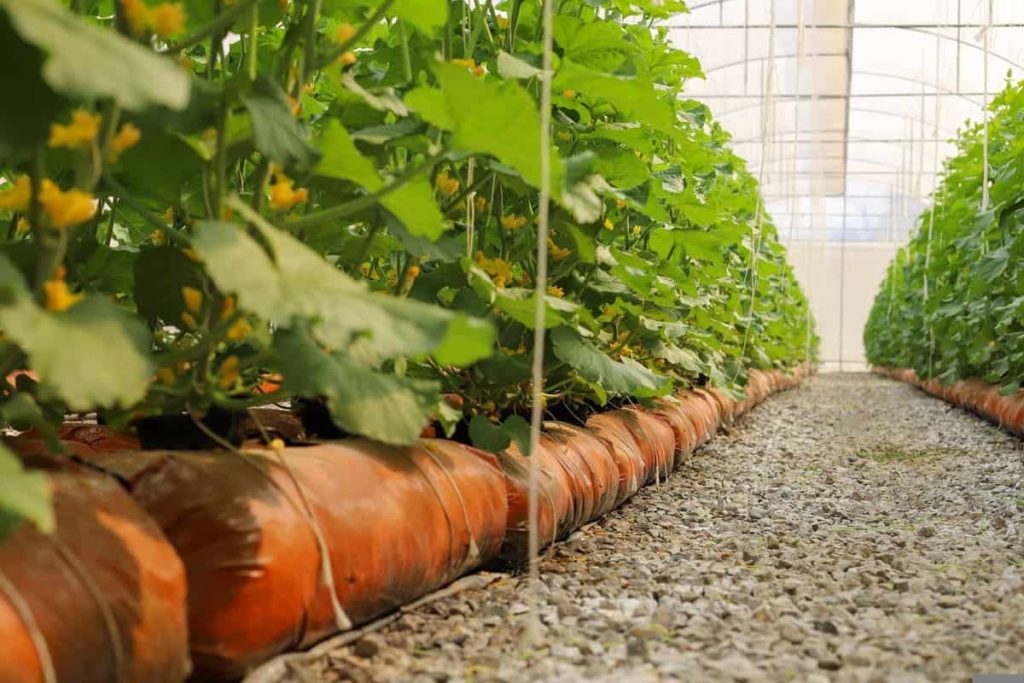
Pests
Cucumber beetle
Their attacks can begin before the seedlings emerge from the ground and are often fatal to young plants. Stunted growth is another sign of the cucumber beetle problem. However, cucumber beetles do not just prey on small plants and remain a threat in the growing season.
Solution – Handpicking and fabric row covers are effective control measures.
Hoppers
Cantaloupes are also prone to attacks from hopper insects, such as leaf hoppers and grasshoppers. Leaf hopper’s symptoms include black spots on leaves and fruits.
Solution – Insecticidal soaps can be effective against nymphs, but adult leaf hoppers are hard to manage.
The grasshoppers discriminate in pests, mostly feeding flowers and vegetable garden plants, and can consume whole plants.
Solution – Like the leaf hoppers, grasshoppers are difficult to control. However, handpicking is effective for minor attacks, and you can use metal window screening for row covers.
Squash bugs
Like whiteflies and aphids, squash bugs eat the sap of growing plants, resulting in wilt and eventually the death of plants. Early signs include small spots on leaves, yellow, brown, or scattered leaves, and rapidly wilting.
Solution – Squash bugs accumulate at the plant base, so hand picking is encouraged for small populations. Alternatively, boards placed near garden plants can be used as nets. Squash bugs seek shelter under boards; one day or so, pick up the board and destroy the bugs with your shoes or a hoe.
Conclusion
Cantaloupes are enjoyed around the world because their growth is usually quite simple, although there are some problems that gardeners can face along the way. The biggest problem with growing Cantaloupes is the tendency to decrease the color of leaves, which can be solved by using pesticides and fungicides or changing the amount of water they get. Ensure you give too little water to your Cantaloupe plants and avoid using chemical pesticides in your garden; this will help better pollinate bees.
- How to Grow Hibiscus from Flower
- Plantation Ideas for Home Decoration: A Beginners Guide
- Flower Garden Designs and Layouts for Beginners
- Planting and Spacing Techniques in Papaya: A Beginner’s Guide
- Growing Gold: Essential Techniques for Planting Pineapples
- How to Make Kalanchoe Plant Bushy: Home Remedies and Solutions
- 11 Reasons Why Your Gardenia is Not Blooming: Home Remedies and Solutions
- Eco Elegance: The Guide to Designing a Drought-Tolerant Landscape
- Gardening on a Slope: Strategies for Hillside Landscaping
- Nourish and Flourish: Top Organic Mulches for Thriving House Plants
- Everything You Want to Know about Indian Mogra Flower: Discover Uses and Growing
- Green Thumb Success: Expert Tips for Cultivating Greenhouse Pumpkins All Year Round
- Maximize Growth & Flavor: The Ultimate Guide to Companion Planting in Herb Gardens
- How to Control Rhododendron Problems Naturally: Home Remedies and Organic Ways to Fix Them
- Natural Magic: The Remarkable Benefits of Cinnamon for Plants
- Best Steps to Revive Dying Tulip with Natural and Organic Treatment
- 10 Reasons Why Your Angel Trumpet is Not Blooming: Remedies and Treatment
- How to Fix Periwinkle Leaf and Flower-Related Problems: Natural Remedies and Solutions
- How to Fix Zinnias Leaf and Flower Problems: Discover Natural and Home Remedies
- Organic Steps to Induce Lemon Tree Flowers: A Comprehensive Guide
- Bloom Booster: Crafting the Perfect Homemade Bougainvillea Fertilizer
- Optimizing Growth: A Guide to Applying NPK Fertilizer for Potted Plants
- 10 Best Homemade Fertilizers for Rubber Plant: DIY Recipes and Application Method
- How to Boost Female Pumpkin Flowers: Effective Steps for More Flowers and High Yields
- Transform Your Indoor Garden: Top Benefits of Pink Salt for Houseplants
- 10 Best Homemade Fertilizers for Peacock Plants (Calathea): Easy DIY Guide
- Unlock Blooms: 9 Reasons Why Your Potted Chrysanthemum is Not Blooming
- 8 Reasons Why Your Potted Hibiscus is Not Blooming: Fix it with Simple Solutions
- Unlock Blooms: 9 Key Reasons Your Potted Frangipani Won’t Flower
- 10 Reasons Why Is My Ice Plant Not Blooming: Remedies and Treatment
- 10 Reasons Why My Potted Hydrangea Not Blooming: Treatment and Remedies
- 10 Reasons Why is My Wisteria Not Blooming: Remedies and Treatment
- 10 Reasons Why is My Goldfish Plant Not Blooming: Remedies and Treatment
- Maximize Your Space: Ultimate Guide to Balcony Gardening with Grow Bags
- 10 Reasons Why Your Iris is Not Blooming: Remedies and Treatment
- 10 Reasons Why Your Anthurium Plant is Not Blooming: Treatment and Remedies